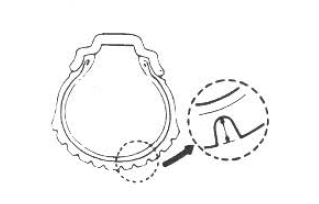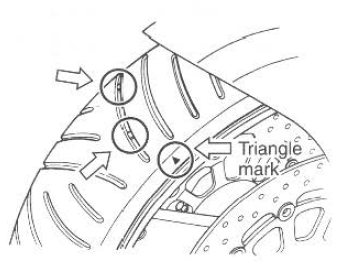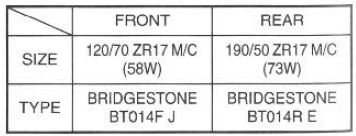Suzuki GSX-R 1000 Owners Manual: Tire condition and type
Tire condition and tire type affect motorcycle performance. Cuts or cracks in the tires can lead to tire failure and loss of motorcycle control. Worn tires are susceptible to puncture failures and subsequent loss of motorcycle control.
Tire wear also affects the tire profile, changing motorcycle handling characteristics.

Check tire conditions each day before you ride. Replace tires if tires show visual evidence of damage, such as cracks or cuts, or if tread depth is less than 1.6 Mm (0.06 In) front, 2.0 Mm (0.08 In) rear.

Note
: the ''triangle mark" indicates the place where the wear bars are molded into the tire.
When the wear bars contact the road, it indicates that the tire wear limit has been reached. Whenever you replace a tire, use a tire of the size and type listed below. If you use a different size or type of tire, motorcycle handling may be adversely affected, possibly resulting in loss of motorcycle control.

Always balance the wheel after repairing a puncture or replacing the tire. Proper wheel balance is important to avoid variable wheelto- road contact, and to avoid uneven tire wear.
 Warning Warning
|
 Warning Warning
|
 Tire pressure and loading
Tire pressure and loading
Proper tire pressure and proper
tire loading are important factors.
Overloading your tires can lead to
tire failure and loss of vehicle control.
Check tire pressure each day
before you ride, ...
 Side standngnition interlock switch
Side standngnition interlock switch
Check the side stand/ignition
interlock system for proper operation
as follows:
Sit on the motorcycle in the
normal riding position, with the
side stand up.
Shift into firs ...
Other materials:
Gearshift shaft construction
Gearshift shaft
Washer
Snap ring
Gearshift shaft return spring
Gearshift cam drive plate
Gearshift plate return spring
8.5 N·m (0.85 Kgf-m,
6.0 Lbf-ft)
13 N·m
(1.3 Kgf-m, 9.5 Lbf-ft)
19 N·m
(1.9 Kgf-m, 13.5 Lbf-ft)
Apply ...
Rear wheel assembly removal and installation
Removal
Loosen the axle nut (1).
Raise the rear wheel off the ground and support the
motorcycle with a jack or wooden block.
Caution
make sure that the motorcycle is supported
securely.
Remove the axle nut (1).
Loosen the left and right lock-nuts (2) an ...
Crankshaft thrust clearance inspection and
selection
Refer to “engine bottom side disassembly” (page 1d-
49).
Refer to “engine bottom side assembly” .
Inspection
With the crankshaft’s right-side and left-side thrust
bearings inserted into the upper crankcase.
Measure the thrust clearance “a” between the leftside
thrust bearing and ...
